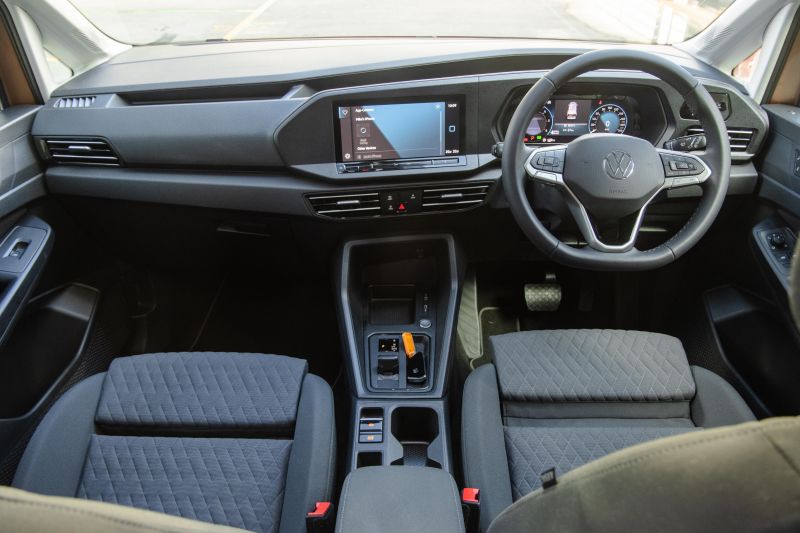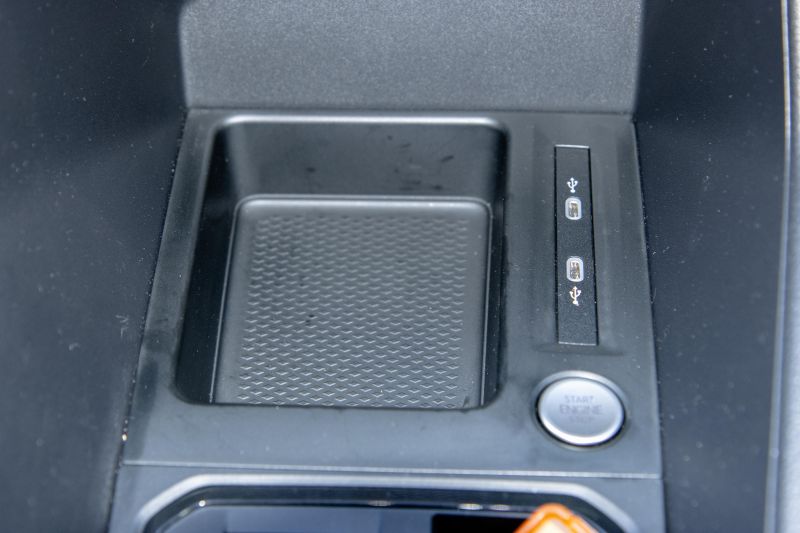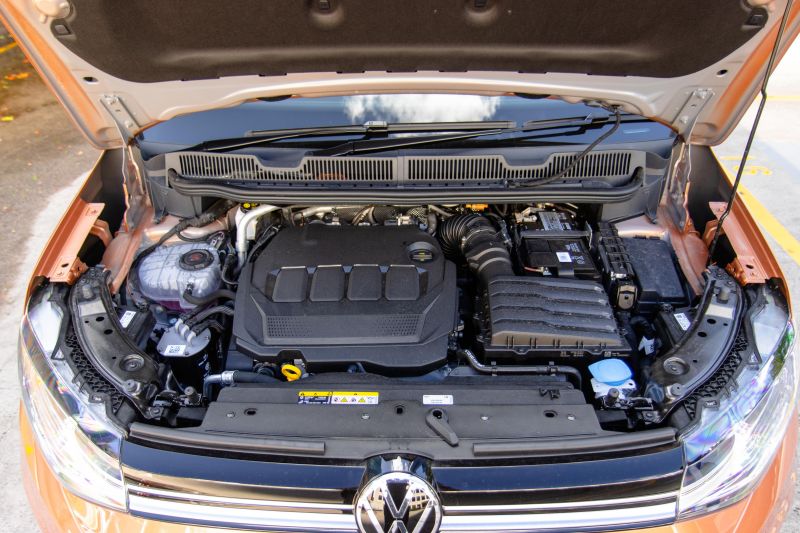Once I’d have been hesitant to suggest a small, European van-based people-mover – despite their undoubted knack of stuffing a lot of seats into a small space (about a foot shorter than a Kia Carnival).
But the latest, Golf-based Volkswagen Caddy makes a compelling case with its curtain airbags for all three seat rows, the latest range of VW Group driver-assist and active safety features, and flashy cabin displays.
Five removable seats also mean it can easily double as a humble hauler on the side, offering something that appears pleasingly versatile, unusual, and downright clever. And with our test’s optional Copper Bronze paint, a huge glass roof, and nice wheels, it even manages to turn heads.
You won’t see these on every street corner, but you can be sure that anyone you see at the wheel has definitely thought laterally about their means of transport.

How much does the Volkswagen Caddy Life Maxi TDI320 cost?
There are two specification grades and two engines available.
The base Caddy Maxi costs $46,140 before on-road costs with the TSI220 petrol engine, and $48,140 for the TDI320 diesel.
The Caddy Maxi Life variant driven here costs $50,640 for the TSI220 petrol and $52,640 for the TDI320 diesel, the latter of which we have here.
Our test vehicle also came with some options, pushing the price-as-tested for our borrowed beast beyond $60,000 plus on-roads – which isn’t exactly cheap.
What do you get?
All Caddy models come with:
- Dual manual sliding doors
- 17-inch steel wheels
- Full-size spare wheel
- Halogen headlights
- Seven seats
- Fabric trim
- Manual air-conditioning
- 8.25-inch touchscreen
- Reversing camera
- Apple CarPlay and Android Auto
- 2 x USB-C outlets
- Digital radio receiver
- LED reading lights
Caddy Life adds:
- 17-inch alloy wheels
- Adaptive cruise control
- Front and rear parking sensors
- Rain-sensing wipers
- Entry and exit lighting
- Privacy glass
- Push-button start
- Dual-zone climate control
- 10-inch digital instrument display
- Heated front seats
- 12V outlet in load compartment
Our test vehicle was optioned with:
- Copper Bronze Metallic paint: $1115
- Fixed panoramic glass sunroof: $1600
- 10-inch touchscreen with sat-nav, wireless phone mirroring: $1660
- LED headlights, DRLs and tail lights: $1675
- 18-inch ‘Monterosso’ wheels with alloy spare: $2285
Is the Volkswagen Caddy Life Maxi TDI320 safe?
Crash tester ANCAP rated it the full five stars against its latest protocols with a 2021 date stamp, awarding it 84 per cent for adult occupant protection, 86 per cent for child occupants, 69 per cent for vulnerable road user protection, and 79 per cent for safety assist features.
Standard safety features include:
- Front, front-side, front-centre, and three-row curtain airbags
- 5 x top tethers and 4 x ISOFIX anchors
- Automatic post-collision vehicle braking
- Drowsy driver monitor
- AEB with pedestrian/cyclist monitoring
- Lane-keep assist
- Blind-spot monitor
- Rear cross-traffic alert
The Life grade adds front sensors with Park Assist, adaptive cruise control, and Travel Assist with Emergency Assist – which effectively combines the active cruise and lane-keeping aids to offer (supervised) autonomous highway stints – for short intervals as mandated.
It all worked as intended, which we suspect is because of scale.
The VW ‘MQB’ architecture underpins Caddy as well as countless other bigger-sellers such as the Golf, meaning the system has evidently been honed and honed and honed.
What is the Volkswagen Caddy Life Maxi TDI320 like on the inside?
It’s odd to find a car with a starter button but no proximity key access, meaning you still need to take the fob from your pocket to unlock it.
In some ways, the Caddy fails to hide its van origins, but on the flipside its rock-hard and solidly-assembled plastic trims are ideal if you plan to have a bunch of kids causing mayhem.
It’s also bright and airy inside thanks to its big glasshouse and slim pillars, plus that optional tinted panoramic glass roof – albeit which lacks a hard cover, which you might long for on a 40-degree day.
There’s also a ton of storage, exemplified by the large open section spanning the width of the dash, and the unusually big door bins.
The manual cloth ‘Ergo’ seats in our upper-grade test version had pull-out under-thigh support and felt really comfortable, while the leather-wrapped steering wheel with flush buttons had plenty of up, down and telescopic movements.
Behind said premium wheel (thankfully bereft of the VW’s latest irritating haptic touchpads) is a large, clear, and fast-to-load configurable digital instrument cluster which like the wheel really modernised the ambience.
The centre display runs one of Volkswagen’s newest infotainment-navigation systems and does a fair approximation of a smartphone, down to its wireless Apple CarPlay. In terms of graphics and processing speed, it’s first rate, swiping and pinching without lag or glitch.
I don’t love the sliding touchpoint interface below though, and the fact you get neither volume or temperature buttons and dials. The latter requires you to hit a shortcut and then make adjustments via a screen menu. The touch-sensitive LED reading lights also suck to use.
Press the small shift-by-wire switch (in lieu of a gear shifter) forwards into reverse, and you’re presented with a clear reversing camera with guidelines. A surround-view camera system would be nice.
Access to the middle seat row comes via tight-parking-spot-friendly sliding side doors, which operate manually but can be optioned with motors. The bench seats three across and offers rear vents, two pull-up tables, and USB-C points.
Entry is made simple thanks to the huge aperture, however legroom isn’t enormous for taller adults unless the front seats are slid forwards. Headroom is not an issue in the least. The side windows don’t open either, which is worth noting.
You pull two tabs on the kerbside portion of the split bench, which causes it to tilt and tumble, and open up the third seating row. The sixth and seventh seats offer more space than most SUVs at this price point, proving sufficient even for adults. No third-row vents or USBs though.
The flexibility factor is high, with the middle and rearmost seats both able to fold flat or be removed altogether in a process that proved pretty simple – albeit requiring you to have some strength and storage room.
The rear tailgate is large and quite bulky in tight spots, behind which sits a rigid cargo cover. The spare wheel sits under the car rather than the load floor. The boot is very capacious, compared to the average SUV.
With seven seats in use there’s still a 629mm by 1185mm space capable of stowing 446 litres. With five seats in use the boot grows to 1452mm long and 1720L in volume, and in van mode to floor is 2265mm long and the cargo volume exceeds three cubic metres (3105L).
What’s under the bonnet?
The 2.0-litre four-cylinder turbo-diesel driven here is the pick of the engine range. It delivers a modest 90kW of power but a more potent 320Nm of torque, the latter between 1500 and 2500rpm, to the front wheels through a seven-speed dual-clutch automatic gearbox.
It’s extraordinarily fuel-efficient, with an ADR claim of 4.9 litres per 100km, which makes some hybrids look thirsty by contrast. Its 50L tank means a range nudging 1000km is feasible. It also has idle stop/start and uses AdBlue.
The other drivetrain option is a 1.5-litre turbocharged petrol with 84kW and 220Nm which, frankly, looks on paper to be a bit underpowered. It’s front-drive, uses a seven-speed DSG, and uses a claimed 6.2L/100km.
How does the Volkswagen Caddy Life Maxi TDI320 drive?
It’s quiet for a diesel, with a good stop/start system and smooth DSG, which is a departure from Caddys of old. In fact, don’t consider diesel a dirty word.
It’s also extraordinarily fuel efficient. I averaged a faintly ridiculous good 5.5L/100km on my loops, which about matches a Toyota RAV4 Hybrid. Its 50L tank promises a driving range nearing 1000km.
While the 90kW peak power output looks weedy, it’s saved by 320Nm of torque, which is sufficient to offer muscular rolling response even when you’re more laden.
Dynamically it feels fairly car-like in low-stress driving, as its platform suggests, even though it has a rigid rear axle setup. It’s nearing SUV-levels of big bump suppression and body control in corners, which took me by surprise.
Noise suppression isn’t great though, with plenty of rush roar and tyre noise permeating the cabin at higher speeds, particularly over coarse-chip tarmac.
Payload is 710kg and towing capacity is 1500kg.
How much does the Volkswagen Caddy Life Maxi TDI320 cost to run?
Volkswagens come with a five-year, unlimited-kilometre warranty.
Servicing costs are quite reasonable, with a five-year ‘Care Plan’ costing $1500 for vehicles purchased before June 30, which is essentially five years’ worth of maintenance for the price of three.
If you pay as you go, the cost of each of the first five services at intervals of 12 months or 15,000km are, respectively, $490, $695, $490, $781, and $490. Seems a no-brainer to go for the Care Plan…
CarExpert’s Take on the Volkswagen Caddy Life Maxi TDI320
It’s pretty expensive, and shows its commercial origins when it comes to noise suppression.
However, the Caddy Maxi Life is one of the more interesting, charming, practical and efficient family SUV alternatives I can think of.
Click the images for the full gallery










































